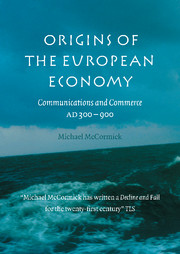Book contents
- Frontmatter
- Dedication
- Contents
- List of maps
- List of figures
- List of tables
- List of charts
- Preface
- List of abbreviations
- Commerce, communications, and the origins of the European economy
- PART I THE END OF THE WORLD
- 1 The end of the ancient world
- 2 Late Roman industry: case studies in decline
- 3 Land and river communications in late antiquity
- 4 Sea change in late antiquity
- The end of the ancient economy: a provisional balance sheet
- PART II PEOPLE ON THE MOVE
- PART III THINGS THAT TRAVELED
- PART IV THE PATTERNS OF CHANGE
- PART V COMMERCE
- Appendices
- Bibliography
- Index
4 - Sea change in late antiquity
from PART I - THE END OF THE WORLD
Published online by Cambridge University Press: 05 February 2015
- Frontmatter
- Dedication
- Contents
- List of maps
- List of figures
- List of tables
- List of charts
- Preface
- List of abbreviations
- Commerce, communications, and the origins of the European economy
- PART I THE END OF THE WORLD
- 1 The end of the ancient world
- 2 Late Roman industry: case studies in decline
- 3 Land and river communications in late antiquity
- 4 Sea change in late antiquity
- The end of the ancient economy: a provisional balance sheet
- PART II PEOPLE ON THE MOVE
- PART III THINGS THAT TRAVELED
- PART IV THE PATTERNS OF CHANGE
- PART V COMMERCE
- Appendices
- Bibliography
- Index
Summary
It is hard to overemphasize how deeply the Mediterranean pervaded imperial civilization. The great cities clustered around its beaches, while its climate shaped the Roman lifestyle and food production, fostering the classic dietary triad of wheat, oil, and wine. Its fish adorned the Romans' mosaics and flavored their dishes. Above all, the mastery of its waters allowed the unprecedented degree of interregional economic specialization and integration which accompanied political and cultural unification. The main reason for this economic importance has been noted many times. Moving goods by sea was dramatically cheaper than moving them by land. Diocletian's Edict on Prices substantiates the classic observation that it cost less “to ship grain from one end of the Mediterranean to the other than to cart it 75 miles.” To understand the fate of the ancient economy, it is essential to grasp a few facets of late Roman shipping. The key structural issues are the relation between sea transport and commerce, the impact of state subsidies on shipping, and the characteristics of ports, ships, and their cargoes. They will prepare us to consider the profound changes in the shipment of goods around the Mediterranean that archaeologists are now uncovering; these are matched by changes in the shipping itself. They culminated in the seventh century and created an entirely new seascape in the eighth.
Transport and commerce
Sea transport was inherently cheaper. But was it commercially significant? Recent studies have emphasized that, in volume, the greatest shipments were non-commercial transports of state supplies.
- Type
- Chapter
- Information
- Origins of the European EconomyCommunications and Commerce AD 300–900, pp. 83 - 114Publisher: Cambridge University PressPrint publication year: 2002



